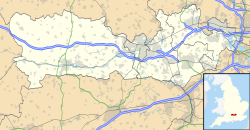Church of St Mary the Virgin, Aldermaston
| Church of St Mary the Virgin | |
|---|---|

A view of the church from the graveyard
|
|
|
Location of the church within Berkshire
|
|
| 51°22′51″N 1°08′39″W / 51.3807°N 1.1442°WCoordinates: 51°22′51″N 1°08′39″W / 51.3807°N 1.1442°W | |
| Location | Church Road, Aldermaston, Berkshire |
| Country | United Kingdom |
| Denomination | Anglican |
| History | |
| Founded | Mid 12th century |
| Dedication | St Mary the Virgin |
| Architecture | |
| Functional status | Active |
| Heritage designation | Grade I |
| Style | Norman |
| Administration | |
| Parish | Aldermaston |
| Deanery | Bradfield |
| Archdeaconry | Berkshire |
| Diocese | Oxford |
The Church of St Mary the Virgin, Aldermaston is the Church of England parish church of Aldermaston in Berkshire. The church, which is dedicated to St Mary, dates from the mid-12th century and has examples of Norman and Jacobean architecture. The building has had a number of extensions, particularly in the 13th, 14th, 15th and 17th centuries.
The Church of England parish church was built in the mid 12th century. The Norman building was altered throughout the following millennium. The 12th century building now comprises the current nave, with additions seen in the Forster Chapel and chancel (13th century), the steeple (14th century), and vestry (17th century). The 17th century Jacobean pulpit is an unusual heptagonal design. Various additions were made to the structure in the 14th and 15th centuries, primarily to the walls and ogee windows. A scratch dial was added to the south-west buttress in the 14th century.
In 1896 Charles Keyser oversaw and funded the church's renovation, which was guided by Edward Doran Webb. Alongside the routine repairments to paving and roofing, the renovation uncovered evidence of an early water drainage system in the sill of a window. This was converted into a piscina. Also, the repairs to the walls of the nave showed that they were lined plaster upon a wooden framing – this was removed, and after repairs, the walls were decorated with tempera artwork. The stained glass in the chancel is the work of C.E. Kempe.
...
Wikipedia

